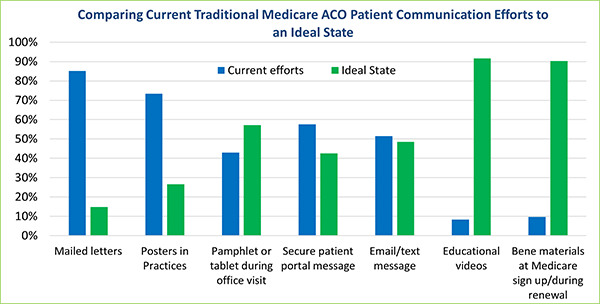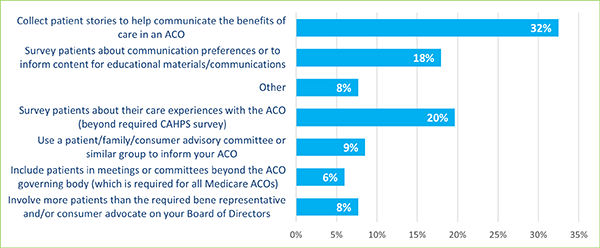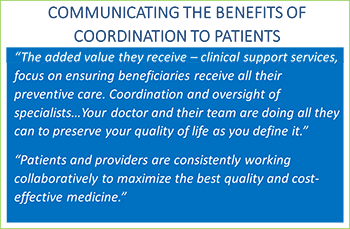- Home
- About Us
- Membership
- Partners
- Resources
- Education & Events
- Advocacy
- Advocacy Letters
- COVID-19
- Shared Savings Program
- Medicaid ACOs
- CMMI Models
- ACO Program Elements
- Quality and Equity
- Congress
- Payment Rules
- Other Regulations
- News
- ACO News
- NAACOS Blog
- NAACOS In the News
- NAACOS Member News
- Press Releases & Letters
Survey Results: ACO Patient Engagement StrategiesWith nearly 52 percent of American adults suffering from at least one chronic condition, "Patient engagement" can mean different things to different audiences. For this survey, it was defined as including the following:
Survey Methodology Key FindingsACOs highly value patient engagement and regularly solicit patient input. Clinicians in ACOs have been evaluated on To support ACOs’ goals and patient engagement prioritization, ACOs solicit patient feedback on a variety of initiatives. The survey asked how often ACOs seek patient feedback on communications preferences, ACO initiatives, or strategies. Thirty percent of survey respondents report that they very frequently or frequently solicit patient feedback. The PE Workgroup shared a variety of initiatives for which they have solicited patient feedback, including the following items and more:
Receiving patient input on these initiatives can help ACOs improve them and increase their effectiveness. ACOs utilize a variety of patient engagement strategies and activities. Recognizing that ACOs are regularly seeking patient input on a variety of topics, it is important to understand the ways in which they are getting that input. The survey asked ACOs to share the specific activities they do or are planning to do in the next year. Chart 1: Patient Engagement Activities
Those that selected "Other" were asked to provide more detail which included the following activities:
The activities above show the breadth of ways ACOs solicit patient input and what that feedback is used for. A requirement for Medicare ACOs is they must include a beneficiary representative on their governing body and many other payers have similar requirements. However, the survey results show some ACOs go beyond the basic requirements to get richer input from patients. To learn best practices for recruiting and engaging patient representatives in ACO governance and initiatives, please refer to this NAACOS resource. ACOs communicate about what it means for patients to receive care in an ACO. When asked what information is most important to communicate to beneficiaries about their participation in an ACO, many survey respondents emphasized the positive. For example, explaining additional benefits or services, such as extra clinical support and coordination across clinicians in different settings and fields of expertise. Survey respondents commented that it is helpful to emphasize the benefits of establishing a primary care relationship, managing chronic diseases, and seeking the right care in the right setting to avoid an emergency room visit when appropriate. Additional positive communications included:
In contrast to highlighting positive aspects
It’s not just ACO executives who think it’s important to highlight how patients benefit from value-based care models such as ACOs. A recent United States of Care report, Shifting the Health Care Approach: Quality Over Quantity, underscores that patients have a high level of support for the core concepts of value-based care (VBC). Namely, patients support a system that pays doctors and providers for improving overall health, delivering higher-quality care, and helping coordinate patients’ care. Their research found patients resonate much more with the care improvements from ACOs/VBC as opposed to hearing about the complexities of a particular VBC model. That report is available on this webpage. ACOs would prefer to shift from communicating via paper to more electronic forms of communication. How an ACO communicates to its patients can affect the usefulness of the information. As such, it is important for ACOs to determine the most effective form of communication within certain constraints such as technological and budgetary. When asked about the current state of communications compared to an ideal state, survey respondents favor moving away from mailing letters and relying on in-office posters to using more sophisticated approaches such as educational videos. The timeliness of a message is also important with ACOs sharing that they would prefer to communicate when a beneficiary signs up or renews Medicare coverage. Chart 2 compares current to ideal efforts across a variety of communication channels for traditional Medicare ACOs. Chart 2: Current Versus Ideal State of Communication Efforts for Traditional Medicare ACOs  Some ACOs have different patient engagement strategies/initiatives for different payer populations. While patient populations can vary notably across payer type, nearly 60 percent of survey respondents shared they do not have different patient engagement strategies by payer type. Those who responded “Yes” elaborated, sharing why they have different strategies for various payer types and what those are:
Availability and use of ACO patient engagement tools varies across payers. Another important component of patient engagement is the use of tools and incentives to activate patients in their care. When asked about available patient engagement tools, incentives, and/or flexibilities/waivers across payers, ACO respondents shared that these are very valuable, though availability and use varies across payers. Survey participants were asked to identify which tools and incentives they use by payer to involve patients in their care and incentivize improved health. The payer categories were: Traditional Medicare, Medicare Advantage, Medicaid, and Commercial (non-MA). Survey results showed that ACOs use these tools and waivers the most in their Medicare Advantage contracts, closely followed by Traditional Medicare, then Commercial (non-MA) and Medicaid. When asked which payer type offers the most beneficial patient incentives, tools, or waivers, Medicare Advantage was the clear leader. No respondents selected Medicaid. ACOs participating in the Medicare Shared Savings Program (MSSP), the largest and only permanent traditional Medicare ACO program, have had limited waivers available to date. Despite the Innovation Center's testing of several waivers in ACO demonstrations, most waivers have not been made available in MSSP. CMS should work to expand MSSP waivers and create a process to accept public nominations for waivers in MSSP. Creating a transparent process for adding new waivers to MSSP would increase ACOs’ flexibility to meet the needs of their populations and support CMS's goal to advance accountable care. The prevalence of using specific tools and incentives across payers revealed that telehealth was the most widely used and considered to most meaningfully improve patient care. This is unsurprising given the proliferation of telehealth use during the COVID-19 public health emergency, during which providers were granted additional flexibilities to deliver telehealth services. Chart 3: Patient Engagement Waivers/Tools/Flexibilities That Most Meaningfully Improve Patient Care  When looking at the use of each specific tools/incentive above by payer, the results were largely consistent across payers with the exception of wellness-related benefits. ACOs use those much more frequently with Medicare Advantage and Commercial (Non-MA), which makes sense due to restrictions in traditional Medicare and lack of funding in Medicaid, respectively. Survey respondents provided comments about their use of patient tools ACOs face certain barriers with patient engagement. Successfully engaging patients is not without challenges, which can vary depending on the payer type and/or patient population or individual patient. When asked to identify impediments or policies that create challenges for an ACO’s patient communications and/or engagement, which the ACO would like to see changed, survey respondents expressed significant challenges with traditional Medicare compared to other payers. ACOs noted they would like more flexibility in traditional Medicare to communicate added benefits of being in an ACO, such as enhanced care and services, but many worry this would fall under marketing restrictions. Others said CMS should notify patients of their providers’ participation instead of the ACO or have a co-branded CMS-ACO notice. Other policy challenges identified included: marketing regulations, difficulty for home-based providers to communicate with patients, lack of patient email addresses from Medicare, limitations on waivers and voluntary alignment, less flexibility than what is available for Medicare Advantage, and hard to understand language from CMS. The survey asked also about policies and impediments for risk-based arrangements for other payers (i.e., those outside of traditional Medicare) that create challenges for ACOs’ patient communications and/or engagement, which ACOs would like to see changed or removed. ACOs provided the following feedback on impediments:
MSSP Beneficiary Notification Requirements Some patients believe these communications are part of a scam or that they have been enrolled in a managed care plan without their consent. As a result of the notifications, some beneficiaries choose to opt-out of data sharing without understanding what the data sharing process entails, making it difficult for ACOs to coordinate and manage patients' care effectively. Medicare beneficiaries and consumer advocates have also expressed concerns that the language used in the notifications, which ACOs are not permitted to modify, does not resonate with patients, and may exacerbate mistrust in the health care system. Many survey respondents commented Many comments also criticized the new follow up requirement for which many implementation questions have gone unanswered by CMS, despite repeated efforts to seek clarification. NAACOS will continue to engage with CMS and other stakeholders, including patients and consumer advocates, to improve beneficiary communications as they are critical to expanding the reach of accountable care and to the success of patient engagement activities. ConclusionThis report reveals ACOs’ dedication to engaging patients in their care and learning from them how to improve communications and initiatives designed for patients. As policymakers create and modify ACO program policies, careful consideration should be given to how policy changes affect the patients served by these programs and engagement efforts. More attention should be given to effectively engaging patients and NAACOS encourages ACOs to share their patient engagement stories or challenges with us by contacting us at [email protected]. You can learn more about how ACOs are working to improve patient care and about NAACOS’ patient engagement work on our website and in this ACOs & Patients factsheet. NAACOS would like to thank the ACOs who contributed to this survey! |

 according to
according to  patient satisfaction since the inception of the Medicare ACO programs. Specifically, the Consumer Assessment of Healthcare Providers & Systems (CAHPS) survey is used by Medicare as well as other payers. Further, ACO quality measures in the past decade have emphasized preventive care (e.g., influenza immunizations and screenings for breast and colorectal cancer) and management of chronic diseases (e.g., control of hemoglobin for diabetes, controlling blood pressure, and statin therapy for cardiovascular disease). To be successful on these measures, it has been imperative for ACOs to effectively engage their patients. This dedication is reflected in survey findings, with 66 percent of respondents reporting that patient engagement is a very high or high priority for their ACO. Other ACOs reported that their patient engagement efforts are not limited to the ACO’s work specifically but rather administered more broadly across affiliated health systems’ populations.
patient satisfaction since the inception of the Medicare ACO programs. Specifically, the Consumer Assessment of Healthcare Providers & Systems (CAHPS) survey is used by Medicare as well as other payers. Further, ACO quality measures in the past decade have emphasized preventive care (e.g., influenza immunizations and screenings for breast and colorectal cancer) and management of chronic diseases (e.g., control of hemoglobin for diabetes, controlling blood pressure, and statin therapy for cardiovascular disease). To be successful on these measures, it has been imperative for ACOs to effectively engage their patients. This dedication is reflected in survey findings, with 66 percent of respondents reporting that patient engagement is a very high or high priority for their ACO. Other ACOs reported that their patient engagement efforts are not limited to the ACO’s work specifically but rather administered more broadly across affiliated health systems’ populations.
 of ACOs, other ACO respondents noted that it is important to emphasize what doesn’t change. For example, traditional Medicare beneficiary rights don’t change for patients who are part of an ACO, and they are free to see providers of their choice. Others noted it is important to communicate that there are no additional charges for added services and benefits and that patient data is protected. Many ACOs highlighted the importance of educating patients on the benefits of staying engaged with your care team and how the ACO helps to coordinate care across the continuum. ACOs also expressed the need to dispel misconceptions, such as:
of ACOs, other ACO respondents noted that it is important to emphasize what doesn’t change. For example, traditional Medicare beneficiary rights don’t change for patients who are part of an ACO, and they are free to see providers of their choice. Others noted it is important to communicate that there are no additional charges for added services and benefits and that patient data is protected. Many ACOs highlighted the importance of educating patients on the benefits of staying engaged with your care team and how the ACO helps to coordinate care across the continuum. ACOs also expressed the need to dispel misconceptions, such as: and incentives which adds context to the rankings. Some commenters noted cost-sharing support is particularly beneficial for preventive services and care management programs. Others noted that financial rewards, such as a gift card, for participating in disease or care management programs are valuable though can be challenging to administer. When asked to share feedback on any patient tools/waivers/incentives not included in survey questions, respondents noted the following as beneficial: hospital at home, bonuses for preventive health activities, and direct patient incentives to complete recommended care.
and incentives which adds context to the rankings. Some commenters noted cost-sharing support is particularly beneficial for preventive services and care management programs. Others noted that financial rewards, such as a gift card, for participating in disease or care management programs are valuable though can be challenging to administer. When asked to share feedback on any patient tools/waivers/incentives not included in survey questions, respondents noted the following as beneficial: hospital at home, bonuses for preventive health activities, and direct patient incentives to complete recommended care. that the requirement is costly and burdensome, creating confusion without real value for patients. This is a sore point for ACOs as many would prefer to put their limited resources into programs that provide more tangible benefits to patient care rather than what, as one survey respondent commented, is a “greater burden than benefit.”
that the requirement is costly and burdensome, creating confusion without real value for patients. This is a sore point for ACOs as many would prefer to put their limited resources into programs that provide more tangible benefits to patient care rather than what, as one survey respondent commented, is a “greater burden than benefit.”